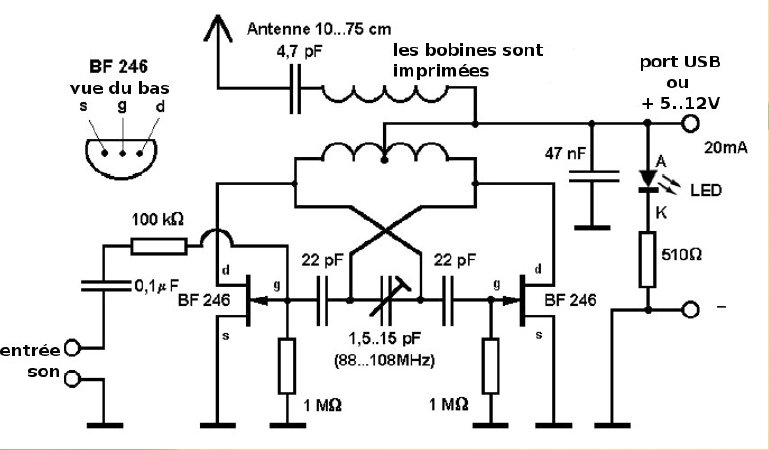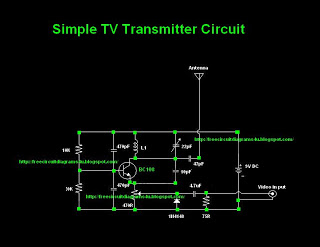
3V FM Transmitter

3V FM Transmitter Circuit. This project provides the schematic and parts list needed to construct a 3V FM transmitter. This FM transmitter is one of the simplest and most basic transmitters to build, offering a useful transmitting range.
The 3V FM transmitter circuit is designed for simplicity and efficiency, making it an excellent choice for beginners in electronics. The circuit operates on a low voltage of 3 volts, which can be supplied by a pair of AA batteries or a single lithium cell. Its primary components typically include a transistor, resistors, capacitors, and an inductor, forming a basic oscillator circuit.
The core of the transmitter is a radio frequency (RF) oscillator, which generates the FM signal. The oscillator is usually built around a bipolar junction transistor (BJT) or a field-effect transistor (FET). The frequency of the transmitted signal can be adjusted by varying the values of the inductor and capacitor in the circuit, allowing for tuning to different FM bands.
The circuit includes a modulating input, where an audio signal can be introduced, allowing the transmitter to send audio content over the airwaves. This is typically done through a microphone or an audio source connected to the input. The modulation process alters the frequency of the carrier wave according to the audio signal, creating an FM signal that can be received by standard FM radios.
A simple antenna, often a wire of appropriate length, is connected to the output of the transmitter to radiate the signal. The effective range of the transmitter can vary based on the antenna design, power supply, and surrounding environment, but it generally covers a distance of several meters.
The parts list for constructing this circuit would typically include:
- Transistor (e.g., 2N3904)
- Resistors (various values for biasing and stabilization)
- Capacitors (for tuning and filtering)
- Inductor (for frequency determination)
- Audio input source (microphone or audio jack)
- Antenna (wire or telescopic antenna)
- Power supply (2 AA batteries or a 3V lithium battery)
This circuit serves as an excellent educational tool for understanding the principles of radio frequency transmission, modulation techniques, and basic electronic components. It is important to ensure compliance with local regulations regarding radio transmission when using this circuit.3V FM Transmitter Circuit This project provides the schematic and the parts list needed to construct a 3V FM Transmitter. This FM transmitter is about the simplest and most basic transmitter to build and have a useful transmitting range.
It.. 🔗 External reference
The 3V FM transmitter circuit is designed for simplicity and efficiency, making it an excellent choice for beginners in electronics. The circuit operates on a low voltage of 3 volts, which can be supplied by a pair of AA batteries or a single lithium cell. Its primary components typically include a transistor, resistors, capacitors, and an inductor, forming a basic oscillator circuit.
The core of the transmitter is a radio frequency (RF) oscillator, which generates the FM signal. The oscillator is usually built around a bipolar junction transistor (BJT) or a field-effect transistor (FET). The frequency of the transmitted signal can be adjusted by varying the values of the inductor and capacitor in the circuit, allowing for tuning to different FM bands.
The circuit includes a modulating input, where an audio signal can be introduced, allowing the transmitter to send audio content over the airwaves. This is typically done through a microphone or an audio source connected to the input. The modulation process alters the frequency of the carrier wave according to the audio signal, creating an FM signal that can be received by standard FM radios.
A simple antenna, often a wire of appropriate length, is connected to the output of the transmitter to radiate the signal. The effective range of the transmitter can vary based on the antenna design, power supply, and surrounding environment, but it generally covers a distance of several meters.
The parts list for constructing this circuit would typically include:
- Transistor (e.g., 2N3904)
- Resistors (various values for biasing and stabilization)
- Capacitors (for tuning and filtering)
- Inductor (for frequency determination)
- Audio input source (microphone or audio jack)
- Antenna (wire or telescopic antenna)
- Power supply (2 AA batteries or a 3V lithium battery)
This circuit serves as an excellent educational tool for understanding the principles of radio frequency transmission, modulation techniques, and basic electronic components. It is important to ensure compliance with local regulations regarding radio transmission when using this circuit.3V FM Transmitter Circuit This project provides the schematic and the parts list needed to construct a 3V FM Transmitter. This FM transmitter is about the simplest and most basic transmitter to build and have a useful transmitting range.
It.. 🔗 External reference





